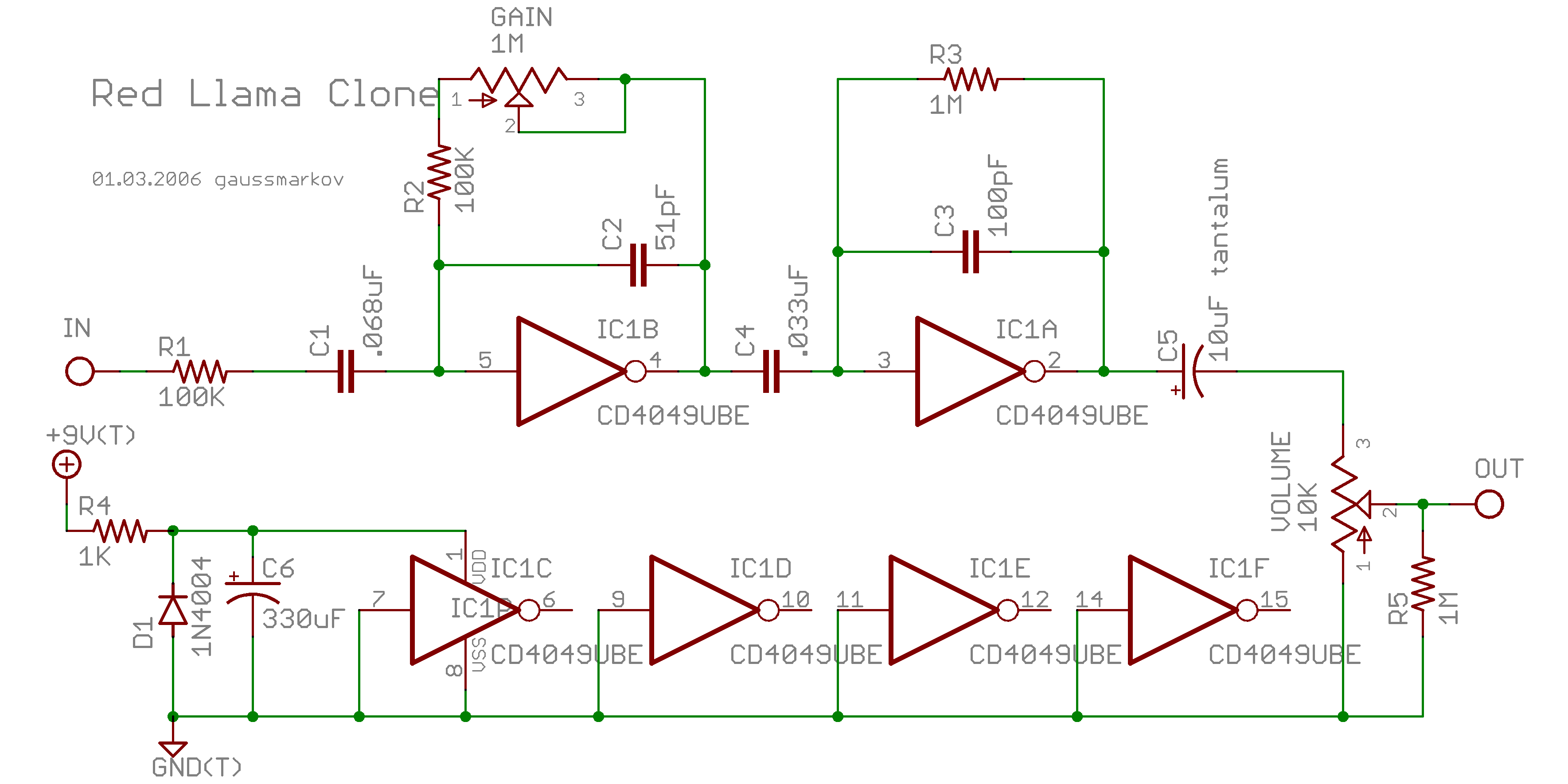I was the proud owner of a Way Huge Red Llama pedal for 30 days last summer courtesy of GC but ended up returning it. I just bought a WHRL clone and found the tone to be noticeably brighter and would like to add a tone trim pot to it (which might eventually end up as a side panel control.) BTW the Red Llama is Jeorge Tripps' version of the Craig Anderton Tube Sound Fuzz.
Here is a schematic of a presumably different clone which I imagine would be similar in architecture. It would be easiest to add a simple variable resistor treble-cut tone control right on the output jack but probably better to insert it in-line to the input of the volume control (as I've seen on many pedal schematics.)
My question is this: what values for the pot and capacitor would be a good starting point? While trimpots are usually linear what taper would be optimum for a panel pot?

http://gaussmarkov.net/layouts/redll...lama-schem.png

%=%=%=%=%=%=%
Here is one drawing of the Tube Sound Fuzz:


Thanks!
Steve Ahola
P.S. So far for ss amps and pedals I've just been cutting and pasting ideas from one circuit to another (not to mention all of the great help I've been getting here at MEF!) but I have a fresh copy of my old culprit in crime coming in: The Op-Amp Cookbook! So I'll be able to better understand the ss circuits I'm looking at.
P.P.S. In comparing the two drawings I guess that I should check the value of the two caps labelled C2 & C3 in the first drawing to see if they have the TSF values of 10pf or the WHRF values of 51pf and 100pf, respectively. That could explain why the clone pedal is much brighter and might make the added tone control unnecessary (I did not miss it with the real Red Llama.) BTW what is the big difference between the CD4049 or CD4069 and the more common op-amps used in FX pedals?
EDIT 4:42PM PDT: I just checked the small pcb with 13 parts (add 2 pots, 2 jacks, a 3PDT footswitch, a battery clip and a DC jack and that is it!) and the ceramic cap nearest the index mark on the CD4049 going CCW is labelled 683 and the one further down is labelled 333. Quick reality check: a larger value cap in the NFB loop of an op-amp should cut more highs- right?
The 3 tantalum(?)caps going CCW from index mark are labelled 16, 101 and 610, with only the first one having a plus mark to indicate polarity.
So I guess that inserting a trimpot and capacitor at the output jack would be the easiest way to go, and once I determine the optimum values I could insert the treble-cut tone control ahead of the volume pot.
Here is a schematic of a presumably different clone which I imagine would be similar in architecture. It would be easiest to add a simple variable resistor treble-cut tone control right on the output jack but probably better to insert it in-line to the input of the volume control (as I've seen on many pedal schematics.)
My question is this: what values for the pot and capacitor would be a good starting point? While trimpots are usually linear what taper would be optimum for a panel pot?
http://gaussmarkov.net/layouts/redll...lama-schem.png
%=%=%=%=%=%=%
Here is one drawing of the Tube Sound Fuzz:

Thanks!
Steve Ahola
P.S. So far for ss amps and pedals I've just been cutting and pasting ideas from one circuit to another (not to mention all of the great help I've been getting here at MEF!) but I have a fresh copy of my old culprit in crime coming in: The Op-Amp Cookbook! So I'll be able to better understand the ss circuits I'm looking at.
P.P.S. In comparing the two drawings I guess that I should check the value of the two caps labelled C2 & C3 in the first drawing to see if they have the TSF values of 10pf or the WHRF values of 51pf and 100pf, respectively. That could explain why the clone pedal is much brighter and might make the added tone control unnecessary (I did not miss it with the real Red Llama.) BTW what is the big difference between the CD4049 or CD4069 and the more common op-amps used in FX pedals?
EDIT 4:42PM PDT: I just checked the small pcb with 13 parts (add 2 pots, 2 jacks, a 3PDT footswitch, a battery clip and a DC jack and that is it!) and the ceramic cap nearest the index mark on the CD4049 going CCW is labelled 683 and the one further down is labelled 333. Quick reality check: a larger value cap in the NFB loop of an op-amp should cut more highs- right?
The 3 tantalum(?)caps going CCW from index mark are labelled 16, 101 and 610, with only the first one having a plus mark to indicate polarity.
So I guess that inserting a trimpot and capacitor at the output jack would be the easiest way to go, and once I determine the optimum values I could insert the treble-cut tone control ahead of the volume pot.



Comment